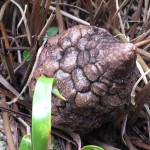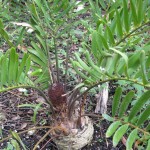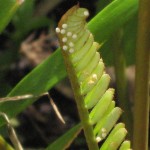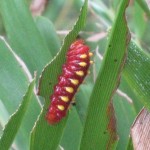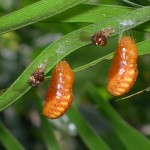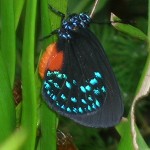Cycads
If you are only passingly familiar with cycads, you’re missing out on one of the most ancient and interesting representatives of the plant kingdom. The first cycads arose somewhere around 280 million years ago, but came into their own in the Jurassic Period, the same time dinosaurs began to dominate, roughly 200 to 145 million years ago. But you can’t say that’s when cycads really flowered, because they’re not flowering plants. Significantly more primitive than flowering plants, they reproduce by way of cones, some of which are very large and/or colorful.
Cycads are dioecious, that is, each is either male or female. In many species, when seeds reach full size, they still don’t have an embryo. That requires a wait of several additional months. And, unlike what we are used to seeing in more modern plants, the flesh that covers the seed is not considered fruit, even though many animals eat it; it is known instead as sarcotesta. Although cycads contain a toxin, humans discovered that it is water-soluble and have long processed the stems for food. One such plant is Zamia integrifolia, formerly Zamia pumila, the only cycad native to the U.S.A. Native American tribes found that the starchy subterranean stem, or caudex, could be rendered into a bread. Eventually the name coontie, derived from a Seminole phrase, was applied to this cycad.
Nearly 200 years ago, settlers around what would become Ft. Lauderdale learned the technique for making coontie edible, and by 1845 a number of starch mills had sprung up in the future Broward and Dade counties, where large colonies of the cycad grew. By around 100 years ago, the name Florida Arrowroot had been applied to the coontie starch. During the early years in Miami, mills would take barrels of the plump roots to Brickell’s Trading Post, from where they would go by schooner to Key West for sale to northern biscuit makers.
The peak of coontie processing occurred during the first two decades of the twentieth century. During World War I, the federal government bought large quantities of processed coontie starch because it was apparently the first food identified that mustard gas victims could tolerate. In 1919 the largest coontie mill relocated from along the New River in Ft. Lauderdale to Kendall in Dade County, specifically the southwest corner of U.S. 1 and South Kendall Dr., the present-day SW 104th St. One of the mill’s customers was Nabisco. But by 1925 the last commercial starch mill closed its doors. There were two reasons for the rapid rise and descent of the industry: Zamia integrifolia is a very slow-growing plant, and its vast populations could not be replaced as fast as they were being dug up. Moreover, human settlement in southern Florida meant that many coonties were being lost to land-clearing activities to build housing subdivisions.
Depletion of the cycad did more than ruin the arrowroot starch industry. It very nearly wiped out the population of Atala butterflies (Eumaeus atala), whose larvae feed on the leaflets of Zamia integrifolia. In fact, by the middle of the twentieth century, government experts at both the state and federal levels concluded that the butterfly was extinct. Perhaps because it was considered defunct, the Atala was not placed on the federal Endangered Species List. Nevertheless, it began to make a comeback. Concerned citizens began a breeding program to boost populations, and, in a strange irony, homeowners started installing coonties as ornamental plants on the very lands from which the species had been ousted by urban development!
If you would like to play a role in not only restoring the Atala butterfly population, but also adding a decorative touch to your home landscape, be sure to come by the nursery to see our supply of Zamia integrifolia. We have them available in 1-gal. and 3-gal. containers.

